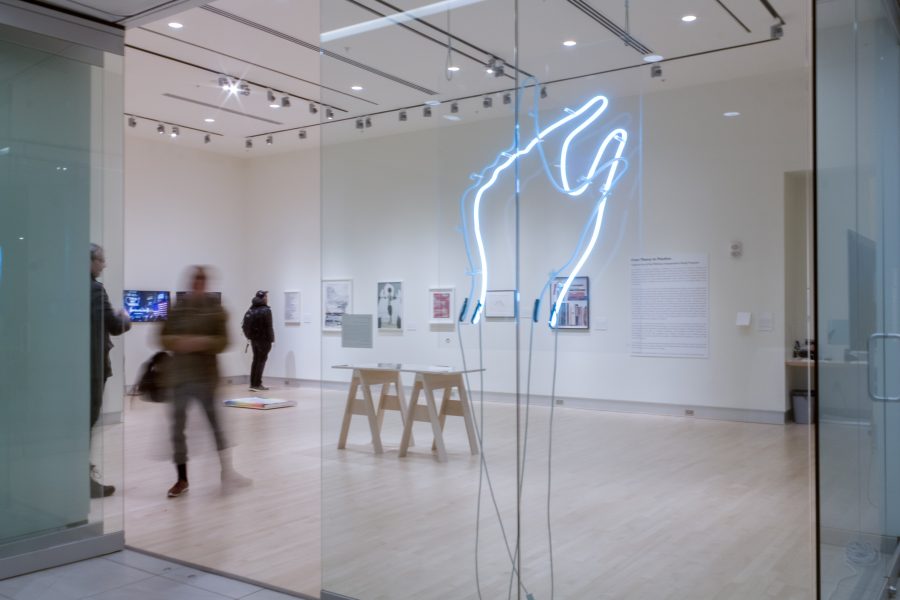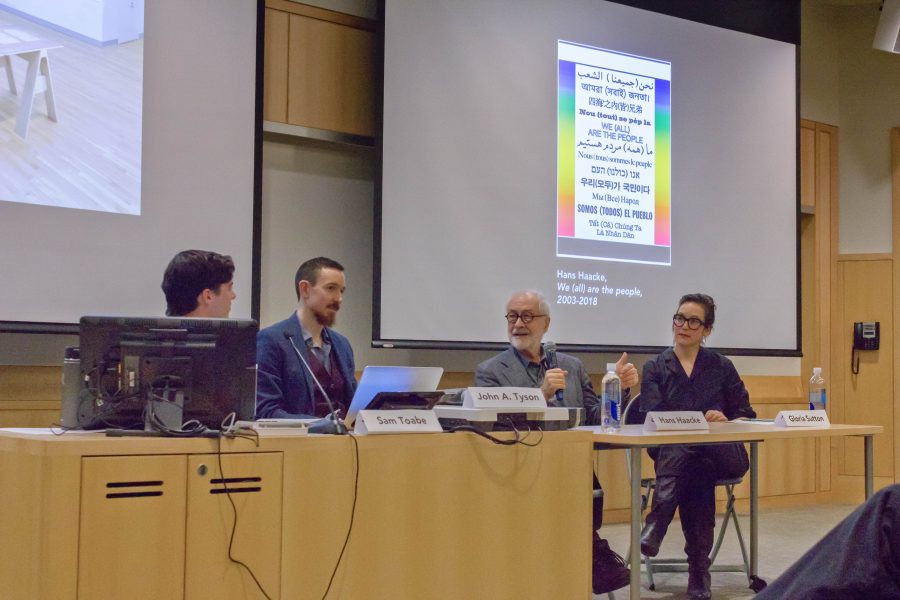Feb. 21, 2019 brought artist Hans Haacke and art historian Gloria Sutton to the University of Massachusetts Boston through a gallery showing and talk on the importance and influence of the Whitney Museum of American Art’s Independent Study Program (ISP). The talk itself entirely filled the University Hall lecture hall and around 84 people showed up afterwards to the gallery to enjoy food and the art on display as well as meet the speakers. The Whitney is located in the art hub of New York City. “From Theory to Practice: Trajectories of the Whitney Independent Study Program” is curated by Assistant Professor of Art John A. Tyson and Gallery Director Sam Toabe. It’s UMass Boston’s “first exhibit to survey the impact of the Whitney Museum of American Art’s Independent Study Program on contemporary art.”
The talk started at 5 p.m. and planned to end at 6:20 p.m. so that they could have a Q&A session until 7 p.m. Toabe started the event by introducing what the exhibition would be. “The exhibition presents a selection of artworks from some of the most influential faculty, participants, and seminar leaders in the ISP, with the intention of tracking the ways in which the program has had strong effects and continues to influence critical approaches in artmaking as well as theorizing and historicizing visual art and culture in the late 20th to early 21st centuries.” After the intro they got right into the introductions of Hans Haacke and Gloria Sutton. Haacke is a German artist who first got involved with the ISP back in the late 20th century. His works have been showcased in five documentaries as well as many different art exhibitions around the world and across the United States. He has also taught at many schools and won awards such as the Golden Lion Award at the Venice Biennale in 1993. He is still working as a seminar leader at the ISP.
Sutton was then introduced. She was involved in the ISP from 1997 to 1998 during the nine-month term in “the critical studies portion of the program” and is an Associate Professor of Contemporary Art History at Northeastern University. She is also “a research affiliate in the Art and Culture Technology Program at MIT [Massachusetts Institute of Technology].” Sutton is also an accomplished author who published, “The Experience Machine: Stan VanDerBeek’s Movie-Drome and Expanded Cinema” in 2015.
John A. Tyson, Toabe’s colleague at UMass Boston, was the first speaker. He describes the ISP as, “a kind of alternate art school for budding artists, art historians, and art curators.” Tyson went into the history by telling the audience, “After a trial semester in Fall of 1967, it officially began in Spring of ‘68. A historical moment categorized by it’s radical politics and revolutionary culture.” 2018–2019 marks this school year as the fiftieth anniversary of the creation of the ISP. The three different sections a student can go into are studio, critical, and curatorial; they come together biweekly for seminars led by Ron Clark, Director of the ISP since 1981, or “a visiting luminary—usually an artist, art historian, or theorist of culture.” It was there that Tyson met Haacke while he was writing his dissertation on him.
After Tyson, the microphone was passed, and Sutton took the front stage once again. The art historian went into what she did during her career at Whitney and her influences that shaped how she approaches art now. “When I was in the ISP, I worked for commercial print magazines: Entertainment Weekly, Interview Magazine… I still live off the frequent flyer miles I amassed during my time working for the marketing departments of those publications. So, that’s what paid for me to be in New York at the same time. To be committed to another group of, kind of I would say, sort of destitute people working on archaizing pieces of knowledge. It was probably the most privileged I’ve ever been and the happiest so there’s some correlation there.” She felt as though the conversations happening at the Whitney—conversations not happening in art history departments or in museums—were crucial to what was happening in the scene at the time.
Throughout the panel, they showed slides to enhance the talk. When Haacke was passed the microphone, he spoke on the politics behind his art and the public’s reaction to it. Some pieces had an overwhelming amount of support while others kicked him out of showing his works. His most famous piece is “We (All) Are The People,” it’s a list of different languages. Chosen by where the majority of immigrants come from, the languages are switched depending on where the piece is going to be. The original print said “We Are The People” but when German right-wing nationalists took the saying to mean that only Germans born in Germany were included, Haacke changed the saying by adding “All.” Haacke was able to be interviewed afterwards and when asked about how UMass Boston’s piece came into existence, he answered, “The one that you have here, it was designed last year for Hunter College in New York but the choice of languages was based on research, but I tapped into which are the dominant, the statistically dominant groups of recent migrants and refugees to this country and who have been singled out by the current president as ‘shit countries’ to come from and so there’s Creole, Arabic, and a couple of others.”
Located on the first floor, closer to the back of the building, of University Hall, the UHall Art Gallery is open Monday through Sunday 12 p.m. to 6 p.m. and the “From Theory to Practice: Trajectories of the Whitney Independent Study Program” exhibit will be up until March 8, 2019.
Guest speakers presenting on UHall.


